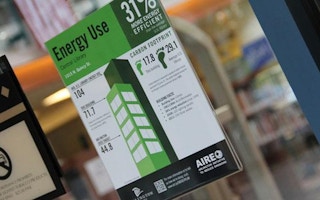Having covered the green building industry in Singapore for years, I have witnessed the rather remarkable growth of the sector and the journey it has made from relative obscurity in this area to the international recognition Singapore has won for its leadership in green building development, particularly for the tropics.
One criticism I often hear, though, is despite the impressive rate of adoption of green building technologies and certifications, there is just not enough information sharing and public disclosure about the performance of such green buildings, even in the public sector.
Many green buildings may achieve high ratings under the Building and Construction Authority’s (BCA’s) flagship Green Mark scheme, which rates buildings for its sustainability performance, but users of such buildings are none the wiser about its energy efficiency.
Industry professionals also say the information on the performance of the building is not publicly available, making it hard to determine whether such buildings achieve the energy efficiency rating it professes on paper – and whether this performance is kept up over the years.
On Friday at the BCA Breakfast Talk for CEOs held at the International Green Building Conference, the BCA took steps to address this when it gave the industry a peek into its new third green building masterplan.
Among other initiatives, it will soon introduce voluntary disclosure of a building’s energy performance. This means that building owners will start making such information publicly available; the BCA will be naming the top 20 per cent of energy efficient buildings with the consent of building owners and at a later stage, will encourage owners to display building energy certificates in their lobby or foyer areas.
This is an encouraging move and a long time coming.
“
Enabling visitors to see such energy performance certificates, along with the Green Mark rating, in public areas will help to raise public awareness about the importance of green buildings in helping Singapore mitigate its carbon footprint and raising productivity and general well-being of its occupants.
In one separate session that I attended at the conference, a researcher had mentioned that although the BCA’s Green Mark scheme is well known and established within the industry, for the general public, the link between identifying a green building and the Green Mark scheme remains weak.
Enabling visitors to see such energy performance certificates, along with the Green Mark rating, in public areas will certainly go in some way to address this issue. It will also help to raise public awareness about the importance of green buildings in helping Singapore mitigate its carbon footprint and raising productivity and general well-being of its occupants.
At the breakfast talk, which I moderated, industry leaders spent a good part of the morning discussing the ‘value of green to corporations’.
The growth of green buildings in Singapore – from a mere 17 buildings in 2006 to more than 1,600 today comprising 20 per cent of Singapore’s built-up space – has been spectacular. The country has a target to green 80 per cent of its buildings by 2030. That it is on track to achieve this target is testament to the fact that companies here do realise the ‘value of green’ not just to its own operations, but also to their clients and the wider community.
Rod Leaver, chief executive officer for Lend Lease Asia set out the case for change for the industry. The benefits of green buildings include:
- Marketability
- Cost savings
- Talent retention
- High occupancy rates
- Reduced liability risks
Netapp vice president and general manager for Asean, Scott Morris, also shared how the firm’s sustainability efforts have enabled it to rank number 6 on Fortune magazine’s 2013 “100 Best Companies to Work For” list, and this has greatly enhanced its talent retention rates.
Its commitment to green its data centres by developing solutions that reduce the amount of resources used while keeping costs low for its clients have won them a ranking in Forbes’ “World’s Most Innovative Companies” list, which, guess what – enables them to win more business.
You could call sustainability a virtuous cycle.
The panel also had a spirited discussion about BCA’s latest efforts to name the best performers.
Why not also name the bottom 20 per cent? I asked BCA. Such an approach would surely motivate the laggards of the industry to get their house in order.
In response, BCA chief executive John Keung said it would take the “carrot” approach first, by recognising the leaders in the hope of encouraging the others to follow suit. He assured the 250-strong audience: “BCA always takes a consultative approach with any of its new initiatives” but he also did not rule out that such a display of a building’s performance may be made mandatory in the future.
“
Mandatory disclosure is a matter of time if Singapore is serious about greening its dense, built-up infrastructure.
The Singapore public sector should show some leadership and also make it mandatory for all public buildings to do so. It is taxpayers’ money that funds the construction and maintenance of these buildings after all.
In my opinion, such a move is a matter of time if Singapore is serious about greening its dense, built-up infrastructure. Public buildings in the United Kingdom, for example, are already required to display such certificates. The Singapore public sector should show some leadership and also make it mandatory for all public buildings to do so. It is taxpayers’ money that funds the construction and maintenance of these buildings after all.
Chief executive officer and executive director of Keppel REIT Management, Ng Hsueh Ling, expressed some anxiety about naming the worse-off performers. “There are serious repercussions for building owners when such a move is taken. For example, the air quality in a building could be not bad at all, but just not as good as the best in the industry,” she pointed out. So companies should not be unnecessarily penalised in such rankings, she added.
I agree that such concerns must be addressed, and in general, an atmosphere of encouragement in the industry is preferred over naming and shaming. But requiring buildings to display their energy performance can hardly be considered the latter – numbers are hard facts upon which the public and industry can determine and judge for themselves.
It’s similar to how listed companies are required to disclose their financial information and shareholders and anaylsts can judge whether their numbers hold up against their peers according to their unique conditions and business strategies.
After all, transparency has always been a big driver of openness and accountability within industries. I do not doubt that increased transparency in the industry will only serve to spur the local green building movement to greater heights in the years ahead.














